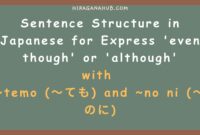Understanding the Usage of “Kara” and “Made” in Japanese

When learning Japanese, understanding basic particles is an essential step to
enhance communication skills. One commonly used combination of particles is
“kara” (から) and “made” (まで). This article will
comprehensively explain their functions, sentence patterns, and examples so
you can effectively apply them in daily conversations.
The Meaning of “Kara” and “Made”
The particle “kara” means “from,” while “made” translates to “until.” This
combination is used to indicate a time range or distance between two specific
points.
For example, you can use it to express a period (such as from morning to
evening) or a location (from one city to another). This pattern frequently
appears in daily conversations, especially when discussing schedules, travel
routes, or activity durations.
“>Basic Sentence Pattern for “Kara” and “Made”
The basic pattern for using these particles is:
~ から ~ まで ~ ます/です
This pattern is usually followed by a verb or adjective to provide more
specific context. It is flexible and easy to understand, even for beginners.
How to Use “から” and “まで”
In Japanese, “kara” and “made” are placed after nouns. Here are some examples
of their usage:
1. Indicating a Time Range
- 私は午前7時から15時まで働きます。(Watashi wa gozen 7-ji kara 15-ji made hatarakimasu.)
- I work from 7 AM to 3 PM.
- 私は午前6時から10時まで勉強します。(Watashi wa gozen 6-ji kara 10-ji made benkyou shimasu.)
- I study from 6 AM to 10 AM.
2. Indicating a Place Range
- ロンドンからパリまで一時間半かかります。(Rondon kara Pari made 1-jikan han kakarimasu.)
- It takes 1.5 hours from London to Paris.
3. Stating Activity Limits
- 休みは水曜日から土曜日までです。(Yasumi wa suiyoubi kara doyoubi made desu.)
- The holiday lasts from Wednesday to Saturday.
- 市の幕展覧会は5日から7日までです。(Shi no maku tenrankai wa itsuka kara nanoka made desu.)
- The exhibition is held from the 5th to the 7th.
Using “から” or “まで” Independently
Although they are often used together, these particles can also stand alone to
indicate just one limit. Here are some examples:
- 休日は明日から始まります。(Kyuu-jitsu wa ashita kara hajimarimasu.)
- The holiday starts from tomorrow.
- 私はドイツから来ました。(Watashi wa Doitsu kara kimashita.)
- I came from Germany.
- 仕事は金曜日までです。(Shigoto wa kinyoubi made desu.)
- The work lasts until Friday.
Tips for Using “Kara” and “Made”
Pay Attention to Context
Ensure you understand the situation before choosing to use “kara” or “made.”
Use both to show a range, or one to emphasize just the starting or ending
point.
Practice Through Conversations
Try integrating this pattern into your daily conversations. For instance, when
explaining schedules or trips, use “kara” and “made” to make your statements
sound more natural.
Combine with Other Expressions
These particles can be combined with verbs like “kakarimasu”
(干ります, takes time) or adjectives to provide richer information.
Understanding “kara” and “made” will greatly help clarify your
communication in Japanese, especially when discussing time or location. With
consistent practice, you will be able to use this pattern naturally in daily
conversations.
Keep practicing and exploring Japanese further! With a solid understanding of
basic particles like “kara” and “made,” you will become more confident and
fluent in communication.


